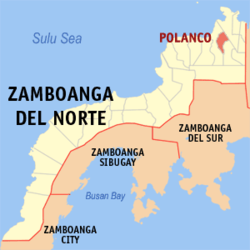Polanco | |
|---|---|
| Municipality of Polanco | |
 Portion of Polanco's Poblacion | |
| Nickname: Marang Capital of the Philippines | |
 Map of Zamboanga del Norte with Polanco highlighted | |
Location within the Philippines | |
| Coordinates: 8°31′55″N123°21′47″E / 8.5319°N 123.3631°E | |
| Country | Philippines |
| Region | Zamboanga Peninsula |
| Province | Zamboanga del Norte |
| District | 1st district |
| Founded | August 22, 1951 |
| Barangays | 30 (see Barangays) |
| Government | |
| • Type | Sangguniang Bayan |
| • Mayor | Shaia Ruth Robins Uy (Lakas) |
| • Vice Mayor | Evan Hope D. Olvis (PFP) |
| • Representative | Roberto T. Uy Jr. (Lakas) |
| • Municipal Council | Members |
| • Electorate | 31,040 voters (2025) |
| Area | |
• Total | 206.88 km2 (79.88 sq mi) |
| Elevation | 25 m (82 ft) |
| Highest elevation | 348 m (1,142 ft) |
| Lowest elevation | 0 m (0 ft) |
| Population (2024 census) [3] | |
• Total | 40,485 |
| • Density | 200/km2 (510/sq mi) |
| • Households | 10,776 |
| Economy | |
| • Income class | 3rd municipal income class |
| • Poverty incidence | 36.48 |
| • Revenue | ₱ 251.8 million (2022) |
| • Assets | ₱ 450.9 million (2022) |
| • Expenditure | ₱ 191.6 million (2022) |
| • Liabilities | ₱ 91.72 million (2022) |
| Service provider | |
| • Electricity | Zamboanga del Norte Electric Cooperative (ZANECO) |
| Time zone | UTC+8 (PST) |
| ZIP code | 7106 |
| PSGC | |
| IDD : area code | +63 (0)65 |
| Native languages | Subanon Cebuano Chavacano Tagalog |
| Website | lgupolanco |
Polanco, officially the Municipality of Polanco (Cebuano : Lungsod sa Polanco; Subanen: Benwa Polanco; Chavacano: Municipalidad de Polanco; Tagalog : Bayan ng Polanco), is a municipality in the province of Zamboanga del Norte, Philippines. According to the 2020 census, it has a population of 42,265 people. [5]
Contents
- History
- Geography
- Barangays
- Climate
- Demographics
- Economy
- Notable personalities
- References
- External links
Most of land of Polanco was owned by the influential family of Realiza, led by Don Gaudencio N. Realiza during the times of American regime in the Philippines. The present land they own are large parts of Labrador (Prinda), Bethlehem, Dansullan, Guinles, Macleodes, New Sicayab, New Lebangon, Sianib, South Polanco, and Obay. [6]



